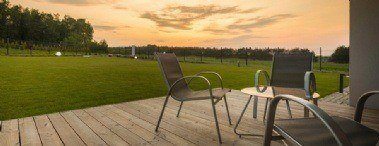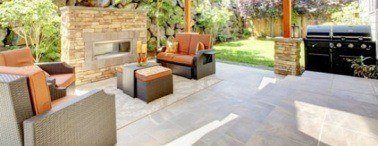
A deck is one of the most versatile, and inexpensive, living space additions a homeowner can make. A deck can add a clean, flat, dry surface over exterior areas that are uneven or muddy. A simple 8 X 8 deck can be built for less than $800, and a handy person can buy the materials and complete the job in a weekend. However, like all other renovations, either large or small, building a deck requires planning and a bit of shopping around.
Deck Use Decides Size and Shape
The first item to consider is the design of the deck. Obviously a large deck will require more materials and this will have a direct impact on the price but the style of deck will also affect the cost. For example, a multi-level deck requires more bracing as does a simple one that is four feet or less above the ground. In addition, building decks that include a built in hot tub will also need stronger supports than on decks that will just be used for relaxing.
Size: One rule-of-thumb is to allow an average space of 4 feet by 5 feet, or 20 square feet for each person. To further illustrate this, if a family includes 2 adults and 3 children then a rough estimate of the size should allow at least 100 to 120 square feet.
This, of course, would not include visitors so extra people should be considered. At the planning stage, you should also consider the rooms through which you will access your deck, the size of your lot, the type of soil and municipal by-laws (size, foundation, materials, etc.).
Where the Deck Will Go
Placement: The positioning of the deck is important for its use. Building a deck in an area of the property, or off the house, that will not be used because of wind patterns or because it has a view of a neighbor's garbage, is wasting money.
- A tried-and-true way of positioning a deck is to plan with relation to the sun's summer trajectory, taking into consideration the location of other buildings, trees, traffic, etc.
- Heavy wind action can be avoided by locating the deck on the leeward side the house.
- Care should be taken not to place the deck area under a wire or tree where birds usually perch or a sap-dripping spruce tree. Not only is this messy, the acids can cause deterioration of wood decking.
- Finally, consider privacy, both for you and your guests and for your neighbors.
Measuring: Next, measure the placement area of the deck. One tip is to design the deck taking into consideration the size of the lumber.
- Since decking comes in sizes of 8, 10, 12 and 16 feet making the deck measurements to these sizes will save extensive cutting and this will save money.
- A square deck is also easier to build and wastes less material than one with rounded edges or is a triangular shape.
Property Lines and Municipal Bylaws
In many states a building permit is required to build a deck regardless of height. It is important that this information is confirmed.
Property Lines: Building a deck and finding out that it infringes on your neighbor's property can lead to its dismantling, and this is a colossal waste of time and money. Check the boundaries with the municipal office and, if the pins cannot be located, hire a surveyor to go over the lines.
Laws: Also, it is very important to research by-laws, zoning ordinances and building codes that affect deck building. For example, in many states the end of a deck must be at least 6 inches from the property line.
Utilities: Another consideration is what will lie beneath the deck. This includes the water supply, sewage line, power, gas and/or telephone conduit.
Materials for Decking
Deck building materials will have a big impact on the price.
Footings: Depending on the bylaws, and the size of the deck, the footings for a large or multi-tiered deck should be concrete.
- This can be accomplished by digging holes and inserting sono-tubes - cardboard forms.
- The concrete can be bought pre-mixed in bags and mixed with water in a wheel barrow or bucket.
- For cold areas of the country the footings should go below the frost line.
- On decks built close to the ground, and on solid ground with good drainage, concrete deck blocks will suffice.
Supports and Stringers: For the best results pressure-treated lumber for bracing should be used. Not only will it last longer than ordinary wood it is much cheaper than redwood or cedar and has almost the same lifespan.
Decking: Once the frame has been built pressure-treated lumber is the popular choice because it is inexpensive and can be stained to almost any color. In circumstances where water is ever-present, such as around hot tubs or swimming pools, redwood, cedar, vinyl or composite decking can be used. Although much more expensive these decks are virtually maintenance-free and will last for years.
If you are unsure about your DIY capabilities or just want an expert's opinion, consult our Contractor Directory or simply post your project online and a qualified decking contractor will contact you.
Posted by: TrustedPros





